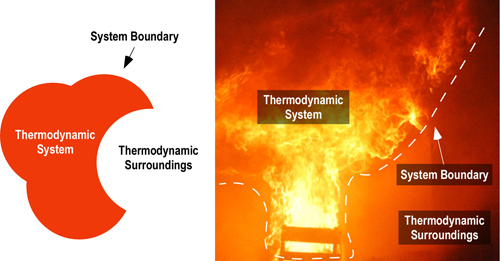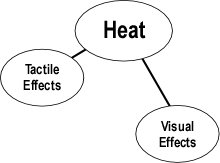Reading the Fire:
Heat Indicators
In Reading the Fire: How to Improve Your Skills, I discussed building a concept map of fire behavior indicators as a method to increase competence in reading the fire. Construction of a concept map increases awareness of key indicators and understanding their interrelationships. I am working through this process along with you, with the latest revision to my concept map. Thus far, I have examined Building Factors, Smoke Indicators, and Air Track Indicators, the first three categories in the B-SAHF (Building, Smoke, Air Track, Heat, and Flame) organizing scheme. For review of the discussion of the work done so far, see the following Reading the Fire posts:
- Building Factors
- Building Factors Part 2
- Building Factors Part 3
- Smoke Indicators
- Smoke Indicators Part 2
- Air Track Indicators
- Air Track Indicators Part 2
Focus Question
The process of developing or refining a concept map identifying fire behavior indicators (FBI) and their interrelationships starts with the following focus question:
What building, smoke, air track, heat, and flame indicators
provide clues to current and potential fire behavior?
As you develop the heat indicators concept map it is likely that you will uncover potential additions to the Building Factors, Smoke, or Air Track Indicators concept maps. You may also identify interrelationships that you may not have thought of previously. Don’t forget to go back and capture these thoughts by adding them to your other maps or placing them in a staging area for further consideration.
Heat and Temperature
Firefighters, like everyone else, have a commonsense understanding of heat and temperature. This is likely where many of our challenges in really understanding thermodynamics begins. The way in which we use the concepts of heat and temperature on a daily basis are likely to be considerably different than they are used in science.
Thermodynamics is a branch of physics that describes processes that involve changes in temperature, transformation of energy, and the relationships between heat and work. Fires and firefighting also involves changes in temperature, transformation of energy, heat and work. “Thermodynamics, like much of the rest of science, takes terms with an everyday meaning and sharpens them – some would say, hijacks them – so that they take on an exact an unambiguous meaning” (Atkins, 2007, p. 3).
Thermodynamics deals with systems. A thermodynamic system is one that interacts and exchanges energy with the area around it. A system could be as simple as a block of metal or as complex as a compartment fire. Outside the system are its surroundings. The system and its surroundings comprise the universe. For example we might consider a burning fuel package as the system and the compartment as the surroundings. On a larger scale we might consider the building containing the fire as the system and the exterior environment as the surroundings.
Figure 1. Thermodynamic Systems

In a compartment fire, energy is exchanged within the thermodynamic system and between the system and its surroundings.
Energy is the ability to do mechanical work or transfer thermal energy from one object to another. Energy can only be measured on the basis of its effects. There are basically two kinds of energy, kinetic and potential. Potential energy is that which is stored and may be released at a later time. The chemical energy contained in fuel that can be released during combustion is one example of potential energy. Kinetic energy is associated with motion of an object. Movement of molecules when heated during combustion is a good example of kinetic energy. Temperature is a measure of average kinetic energy.
The word flow is often used in discussing heat transfer (e.g., energy flows from materials with higher temperature to those with lower temperature). This helps visualize patterns of movement, but it is important to remember that neither energy nor heat is a fluid. Heat is the process of energy transfer due to temperature differences.
It is important to remember that we cannot see energy, temperature, or heat. However, we can see and feel the impact of increases in temperature as a result of heat (energy transfer). Use of the word heat to describe this category of indicators is appropriate as these indicators are all related to transfer of energy within and out of the compartment fires thermodynamic system.
Getting Started
When reading the fire it is important not to focus on a single indicator or category of indicators. In the case of heat, there are many interrelationships with air track and flame indicators. In some cases, it is arguable whether an indicator belongs in one category or the other (likely it is not important as long as you recognize the interrelationships).
As always in developing a concept map it is important to move from general concepts to those that are more specific. Heat Indicators can be divided into two basic categories, those that you can see (visual effects) and those that you can feel (tactile effects) as illustrated in Figure 2. However, you may choose to approach this somewhat differently.
Figure 2. Basic Heat Indicators

Developing the Detail
Expanding the map requires identification of additional detail for each of the fundamental concepts. If an idea appears to be obviously related to one of the concepts already on the map, go ahead and add it. If you are unsure of where it might go, but it seems important, list it off to the side in a staging area for possible additions. Download a printer friendly version of Heat Indicators to use as a starting point for this process.
Next Steps
Remember that the process of contracting your own map is likely as important as the (never quite) finished product. The following steps may help you expand and refine the building factors segment of the map:
- Look at each of the subcategories individually and brainstorm additional detail. This works best if you collaborate with others.
- Have a look at the following video clip using your partially completed map and notes as a guide to identifying important heat indicators. While this video clip is of conditions inside a compartment, also think about how this fire would present if viewed from the exterior.
The following video clip illustrates a recreation of the Station Night Club Fire that occurred in Rhode Island in 2003 that was conducted at the National Institute of Standards and Technology (NIST) laboratory in Gaithersburg, MD
The next post in this series will discuss visual and tactile heat indicators in greater depth and examine the increasing influence of technology in our perception (and misperception) of developing fire conditions.
Ed Hartin, MS, EFO, MIFireE, CFO
References
Atkins, P. (2000). Four laws that drive the universe. Oxford, UK: Oxford University Press
Tags: B-SAHF, deliberate practice, FBI, fire behavior indicators, practical fire dynamics, reading the fire, situational awareness



August 20th, 2009 at 06:03
[…] Reading the Fire Heat Indicators briefly examined energy, temperature, and heat in thermodynamic systems, and introduced the two major categories of heat related fire behavior indicators: those that we can see (visual) and others that can be felt (tactile) as illustrated in Figure 1. […]
August 27th, 2009 at 04:14
[…] Reading the Fire Heat Indicators briefly examined energy, temperature, and heat in thermodynamic systems, and introduced the two major categories of heat related fire behavior indicators: those that we can see (visual) and others that can be felt (tactile) as illustrated in Figure 1. […]
August 1st, 2010 at 15:26
[…] Reading the Fire: Heat […]
September 12th, 2010 at 10:19
[…] Heat Indicators […]
July 17th, 2011 at 08:54
[…] Part 3 Smoke Indicators Smoke Indicators Part 2 Air Track Indicators Air Track Indicators Part 2 Heat Indicators Heat Indicators Part 2 Heat Indicators Part 3 Flame Indicators Flame Indicators Part 2 Incipient […]
July 24th, 2011 at 08:48
[…] Reading the Fire: Heat […]